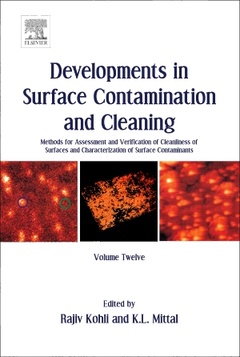Description
Developments in Surface Contamination and Cleaning, Volume 12
Methods for Assessment and Verification of Cleanliness of Surfaces and Characterization of Surface Contaminants
Coordinators: Kohli Rajiv, Mittal K.L.
Language: English
Subject for Developments in Surface Contamination and Cleaning...:
276 p. · 15x22.8 cm · Hardback
Description
/li>Contents
/li>Biography
/li>Comment
/li>
Developments in Surface Contamination and Cleaning: Methods for Assessment and Verification of Cleanliness of Surfaces and Characterization of Surface Contaminants, Volume Twelve, the latest release in the Developments in Surface Contamination and Cleaning series, provides best practices on determining surface cleanliness. Chapters include an introduction to the nature and size of particles, a discussion of cleanliness levels, detailed coverage of measurement methods, characterization methods and analytical methods for evaluating surfaces, and an overview of analysis methods for various contaminants. As a whole, the series creates a unique and comprehensive knowledge base for those in research and development in a variety of industries.
Manufacturing, quality control and procurement specification professionals in the aerospace, automotive, biomedical, defense, energy, manufacturing, microelectronics, optics and xerography industries will find this book to be very helpful. In addition, researchers in an academic setting will also find these volumes excellent source books.
1. Introduction 2. Nature and Size of Particles 3. Product Cleanliness Levels 4. Methods for Monitoring Surface Cleanliness 5. Direct Cleanliness Measurement Methods 6. Indirect Cleanliness Measurement Methods 7. Chemical Characterization Methods 8. Surface Analytical Methods 9. Bulk Analytical Methods 10. Innovative Applications of Characterization Methods 11. Overview of Analysis Methods for Different Contaminants
Dr. Kashmiri Lal “Kash Mittal was associated with IBM from 1972 to 1994. Currently, he is teaching and consulting in the areas of surface contamination and cleaning and in adhesion science and technology. He is the founding editor of the new journal Reviews of Adhesion and Adhesives which made it
- Includes an extensive listing, with a description of available methods for the assessment of surface cleanliness
- Provides a single source of information on methods for verification of surface cleanliness
- Serves as a guide to the selection, assessment and verification of methods for specific applications




